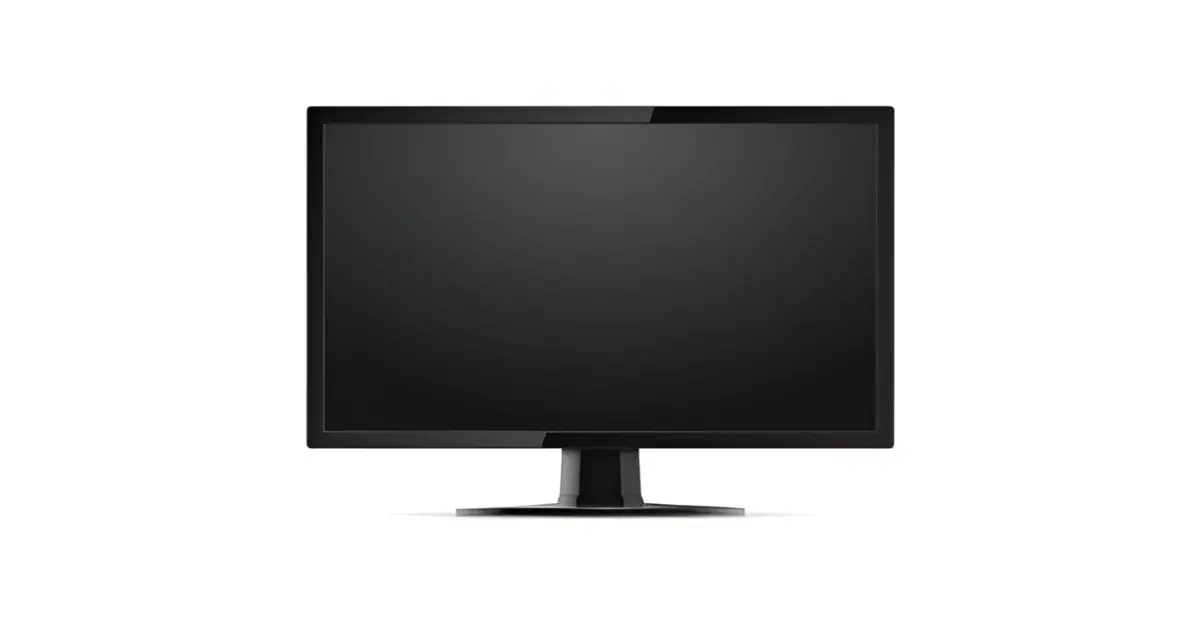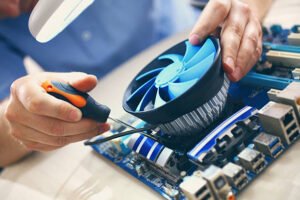Dealing with a monitor that suddenly turns black or blank can be frustrating, especially when you don’t know the causes. This issue is common among users and can happen due to hardware malfunctions, software glitches, incorrect settings, faulty cables, insufficient power, or even malware. A failing graphics card or a loose connection might also be responsible.
Sometimes, the damage is minor, but in other cases, it can be irreparable. Many people report this problem regularly, wondering why their screen keeps going black randomly. Checking reliable sources, following a troubleshooting guide, and seeking expert advice can help identify and fix the issue. If this happens, stay calm and take the right steps to resolve it before it gets worse.
Why Does My Monitor Keep Going Black?
If your monitor keeps blacking out constantly, you’re not alone. This issue can be frustrating, but the reason behind it is often something simple. To find the cause, check different sections of your setup, including connections, power supply, and hardware. Sometimes, unexpected eventualities like overheating or failing components can also be responsible. The best solution is to troubleshoot step by step and identify what needs fixing. A proper diagnosis will cover all possible problems, making it likely that you’ll resolve the issue quickly.
What are Issues and How to Fix Your Monitor?
Damaged or Loose Connections
A malfunctioning screen can often be traced back to damaged or improperly plugged-in cables and connectors, leading to an intermittent signal or no display at all. If your monitor keeps turning off, the first step is to check for loose connections before assuming there’s a bigger problem. A quick fix could be as simple as securing your display cable or testing another power cord.
Steps to Troubleshoot Connection Issues
- Unplug, clean, and reconnect both the power cord and display cable firmly to ensure a stable connection.
- If the issue persists, replace the cables with working ones to pinpoint the culprit.
- Try plugging your monitor into a different power socket or a new port on your GPU or motherboard.
- If you’ve upgraded your monitor, ensure your display cable supports the required resolution and features.
- Older standards like DVI and VGA may not handle high resolutions or extremely fast refresh rates.
Malware or Virus
A malware or virus infection can create serious problems on your computer, sometimes leading to a black screen issue. These malicious programs may interfere with system files, drivers, or settings, causing them to malfunction or even crash. If left unchecked, they can make your system unstable and difficult to use.
To avoid such risks, always use a reliable antivirus software and keep it up-to-date. Make sure to scan your system regularly and be careful when downloading or opening suspicious files or links. If your system is already infected, try using a bootable antivirus tool to remove threats that cannot be detected or eliminated in regular mode.
Wrong or Corrupt Drivers
A wrong or corrupt driver can cause your GPU and hardware to misbehave, affecting how it handles graphics, videos, pictures, and other visuals. If your device is running on old drivers, it may struggle with rendering, leading to poor performance. Some drivers can also be extra finicky, making it essential to update them regularly.
Steps to Fix Driver Issues
- Uninstall outdated or faulty software to avoid conflicts in system instructions.
- Download and install the latest drivers from the official site of your GPU manufacturer instead of relying on Windows or any third-party service.
- If you’re unsure about the exact steps, follow a thorough process by referring to a trusted guide.
- To simplify things, use your brand’s Graphics Control Panel app, as it can provide a link to the correct driver automatically.
- If problems persist, try resetting your GPU to ensure a clean installation.
Incorrect Power Plan
If your monitor keeps turning off suddenly, it might be due to incorrect power options. These settings are designed to save energy but can sometimes cause issues, especially on a laptop. A malfunction in these settings may lead to your display shutting off even when you’re actively using your computer.
Steps to Fix Power Plan Issues
- Access your Power Options through the Control Panel utility.
- Reset your current plan to default to eliminate any misconfigurations.
- Adjust the turn-off timer to Never so your monitor doesn’t shut down when idle.
- If the problem persists, review other settings that might be affecting your display.
Changing your power options can help stop unwanted screen blackouts and keep your monitor running smoothly.
CPU or GPU Overclocking
Overclocking your CPU or GPU can significantly improve performance, but it may also introduce instabilities in your system. If not done correctly, your PC might shut down, your screen could go dark, or games may start crashing. This happens because pushing your components beyond the recommended manufacturer specs increases heat, and if you don’t have high-performance coolers, your machine won’t function properly.
How to Fix It?
To check if overclocking is causing your monitor issues, follow these steps:
- Revert your device to default settings.
- Open the programs where you adjusted the knobs and toggles and dial back all changes.
- Restart your PC to apply the changes.
- Try to replicate the problem by running demanding applications or games.
If your screen no longer turns dark or your PC stops shutting down, then the fix worked. If the problem continues, check your cooling setup and ensure your system is stable.
Graphics-Heavy Software
Not all games and applications are created equal. Some are extremely resource-demanding and need the latest and most powerful hardware to run properly. If your system isn’t up to the task, you might experience lag, crashes, or even a black screen when launching certain titles.
Take Modern Warfare II, for example. As a triple AAA title, it pushes the boundaries of graphics with impressive improvements that make everything look closer to reality. However, this level of fidelity doesn’t come cheap—it requires significant processing power to be seen in all its glory. If your hardware is lacking, you’ll struggle to get a smooth experience.
How to Fix the Issue
The only true fix here is to upgrade your system, especially your GPU. Here’s what to focus on:
- GPU: The most critical component for handling graphics-heavy workloads. Get a model with higher VRAM and better clock speeds.
- CPUs: A strong processor ensures that your game logic runs smoothly without bottlenecks.
- RAM: More memory allows for better multitasking and faster loading times in demanding applications.
If your system can’t handle Modern Warfare II or other resource-demanding games, consider adjusting in-game settings, but ultimately, a hardware upgrade may be the best solution.
Irreparable Monitor Damage
Sometimes, no matter what you do, your desktop may face issues that cannot be fixed. Monitors are delicate units with multiple points where things can go wrong. If you are unlucky, your screen might fail due to various reasons, including mechanical damage, unexpected power surges, or dying pixels that slowly spread over time. The degradation of internal electronics can also make things worse, leading to complete failure.
When Fixing Is Not an Option
There are times when fixing your device is just not possible. Repairs can be expensive, and even if attempted, they might not prove to be worth the cost. Some issues are simply too severe to be fixable. In such cases, rather than wasting money, the best fix is to replace the monitor with a better one.
Signs You Need a New Monitor
- Dead pixels that increase over time
- Frequent power surges that damage internal circuits
- Mechanical damage like cracks or loose connections
- Rapid degradation of electronics causing flickering or color distortion
If your screen reaches this juncture, the only real solution is to invest in a new one before it affects your work or gaming experience.
Frequently Asked Questions
Why does my monitor go black or blank suddenly?
A monitor can turn black due to common causes like hardware malfunctions, software glitches, incorrect settings, or faulty cables. Insufficient power, malware, or a failing graphics card may also be responsible. Checking for a loose connection and securing it can help resolve the issue before it gets worse.
How can I troubleshoot and fix the issue?
Start by checking sections of your setup, including the power supply, to diagnose unexpected eventualities like overheating or failing components. Troubleshoot step by step: diagnose the issue, test possible fixes, and act quickly to prevent further damage.
Can a loose or damaged cable cause my monitor to turn off?
Yes, an improperly plugged-in or damaged connector can cause an intermittent signal, making the display keep turning off. Try securing, testing, or unplugging and reconnecting the cable. If the issue persists, replacing it or trying a working socket might help.
Could my GPU or motherboard be the problem?
If you recently upgraded your GPU or motherboard, ensure it supports the required resolution, features, and standards like DVI, VGA, or high refresh rates. A failing graphics card can also be responsible, so testing with another port or device can help pinpoint the issue.
Can malware or outdated drivers cause this issue?
Yes, a virus or infections in system files or drivers can cause crashes and make the system unstable. Running an up-to-date antivirus scan, avoiding downloading or opening suspicious files, and updating to the latest official manufacturer drivers can help fix performance conflicts.








